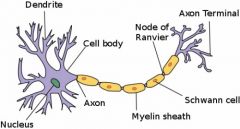![]()
![]()
![]()
Use LEFT and RIGHT arrow keys to navigate between flashcards;
Use UP and DOWN arrow keys to flip the card;
H to show hint;
A reads text to speech;
35 Cards in this Set
- Front
- Back
|
Manifest Content |
what the dream is said to be about by the dreamer - the story the dreamer tells |
|
|
Latent Content |
the meaning underlying the dream. If the symbols from the manifest content are translated by an analyst, they can reveal unconscious thoughts |
|
|
Condensation |
when many thoughts and elements from the unconscious are represented in the dream in one symbol |
|
|
Displacement |
when something that seems to be unimportant in the dream is made central, to shift attention from what is really important |
|
|
Secondary Elaboration |
how the dreamer builds a story when telling what the dream is about, adding to and changing things, which makes analysis hard. |
|
|
Psychoanalysis |
Freud's therapy, designed to help release unconscious thoughts |
|
|
Free Association |
a method used by Freud in psychoanalysis where the patient is encouraged to express a flow of unconsciousness. The process helps to uncover links which can then be interpreted. |
|
|
Slip of the Tongue |
when someone uses the wrong word for something. Freud analysed these slips to help uncover unconscious thoughts. |
|
|
Dream Analysis |
a method used by Freud to help uncover unconscious thoughts by analysing dreams and uncovering symbols |
|
|
Qualitative Data |
data involving stories or attitudes |
|
|
Valid |
refers to findings of studies and means that they are about real-life situations, real-life behaviour or feelings that are real |
|
|
Generalisable |
refers to findings of studies and whether they can be said to be true of people other than those that were studied |
|
|
Subjective |
where the researcher is somehow affecting the information that is gathered, perhaps by their interpretations. |
|
|
Objective |
where the researcher's views do not affect the information that is gathered |
|
|
Neuron |

a cell in the body, including in the brain, that sends information using both electrical and chemical processes
|
|
|
Axon |
a 'cable' that leads from a cell body of a neuron down to the terminal buttons that hold the neurotransmitter |
|
|
Impulse |
the electrical signal that travels from the cell body of a neuron to the terminal buttons where it releases a neurotransmitter |
|
|
Neurotransmitter |
a chemical at the terminal button of a neuron, which is released by the impulse and then goes into the synaptic gap |
|
|
Synaptic Gap |
the gap between the dendrites of one neuron and the next |
|
|
Synaptic Transmission |
what happens when a neurotransmitter released by an impulse of one neuron goes across the synaptic gap and is taken up at the dendrites of another neuron |
|
|
Activation - Synthesis Model |
a model of dreaming proposed by Hobson and McCarley where the brain is active but no sensory information if coming into it. The brain puts the information it has together to make sense of it and this is the dream |
|
|
Random Activation |
during REM sleep, when neurons are active randomly not deliberately |
|
|
Sensory Blockade |
during REM sleep, when no information enters though the senses |
|
|
Movement Inhibition |
the state, during REM sleep, when the body is paralysed and there is no movement |
|
|
Methodology |
refers to how psychology works, including how data is gathered. It involved considering 'how do we know?' |
|
|
Aim |
a statement of what the study is being carried out to find |
|
|
Case Study |
a research method studying an individual or a small group and gathering in depth and detailed information using different means. |
|
|
Qualitative Data |
data involving stories or attitudes |
|
|
Quantitative Data |
data that involved numbers and statistics, such as percentages |
|
|
Generalisability |
refers to findings of studies and how far they can be said to be true of people other than those that were studied. If findings are thought to be true of other people then they are generalisable |
|
|
Reliability |
refers to whether findings from a study would be found again if the study was repeated. A study is reliable if the findings are replicated (found again). |
|
|
Subjectivity |
refers to research methods, where the researcher is somehow affecting the results perhaps by their intepretations |
|
|
Objectivity |
refers to research methods, where there is no bias, for example the researcher's own views have not affected the findings |
|
|
Privacy |
an ethical guideline for studies that involve people as participants, which ensures that their names must not be recorded and they must not be identifiable. Privacy is linked to confidentiality |
|
|
Confidentiality |
an ethical guideline for studies that involve people as participants, which ensures that information gained must not be shared with other without permission. There are some occasions when confidentiality must be broken, however, if there are issues of safety for someone else. Confidentiality is linked to privacy. |

